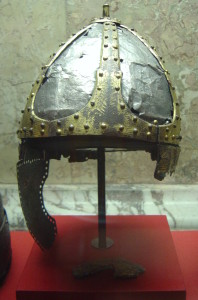In this blog post we will discuss the weaponry and use of military technology presented in The Legend of Broken. The novel takes place near the Harz Mountains in Germany at a time after the fall of the Roman Empire and before the rise of Charlemagne in the later part of the eighth century. We will use the term “dark ages” to refer to the time period between A.D. 400 through 800, which has been also called the Early Middle Ages and the Migration Period.1 In this post we shall address what weapons were available during this time period and how they were used in battle.
The majority of weapons used in the Early Middle Ages and onward include the short- and longbow, the sword in its many variations including daggers and long knives, spears, lances, and halberds, as well as heavier siege artillery such as the siege tower and catapult with its variants, the ballista and trebuchet. Armor came in various fashions and styles, but almost always included the helmet, greaves for leg armor, and scale, chain mail or whole plate armor to cover the torso – made of any number of materials available at the time including iron.
Armor

Swords and Bladed Weapons

Historians have speculated that swords and other bladed war implements were named for the peoples who used them. The Saxons favored the seax, or sax, a type of dagger with wooden or horn hilt used by the Germanic people. Spear implements such as the Frakki or frakka or “Francisca” were used by the Franks during the Merovingian period. The Longobardi were supposedly named — by the Romans — after their long-handled axe, or the long halberd.
Employment of the economic and easily crafted spear was used by cavalry and infantry. The spear consisted usually of only two parts, a leaf-shaped blade wedged into a long wooden staff. Another member of the long-hafted bladed weapon family was the halberd, typically a long handled implement with a metal axe head which was used to cleave and chop.
Bows
There are a few types of bows, but those most commonly found in this particular era and region, according to archaeological record, are short- and longbows, and composite bows. The longbow gets its name from its length which is usually similar in height of the person wielding it (between five and six feet). It is typically constructed from a single piece of wood, usually of the yew tree, but other wood materials have been found just as hardy. The composite bow’s design and construction consists of various materials laminated together such as wood, and animal horn and sinew. Both long- and composite bows were used by infantry soldiers and highly trained horse-mounted archers. Longbowmen required years of training to develop the strength to use a longbow effectively.
In later centuries, the crossbow would eventually replace the longbow completely mainly because of its ease of use and its efficacy of penetrating chain mail due to the mechanical advantage inherent in the mechanism of loading the weapon. | Continue reading →
